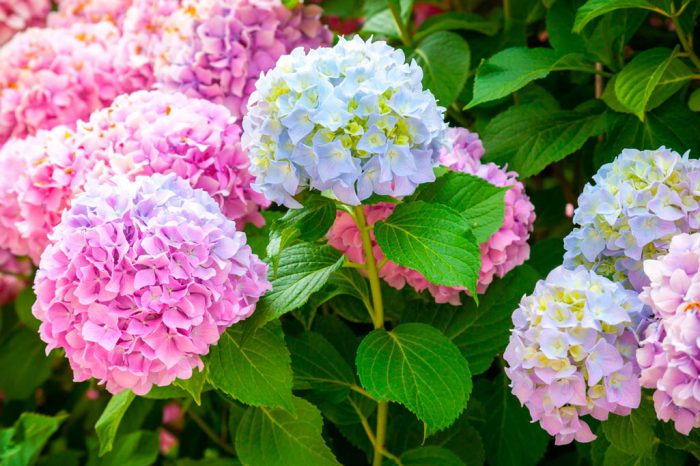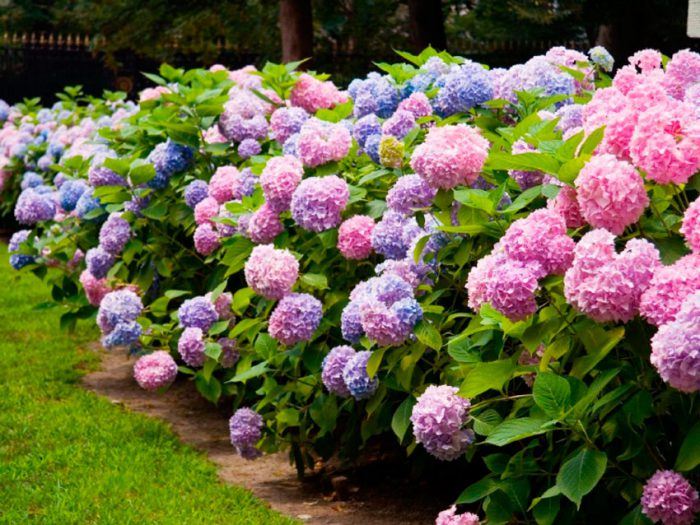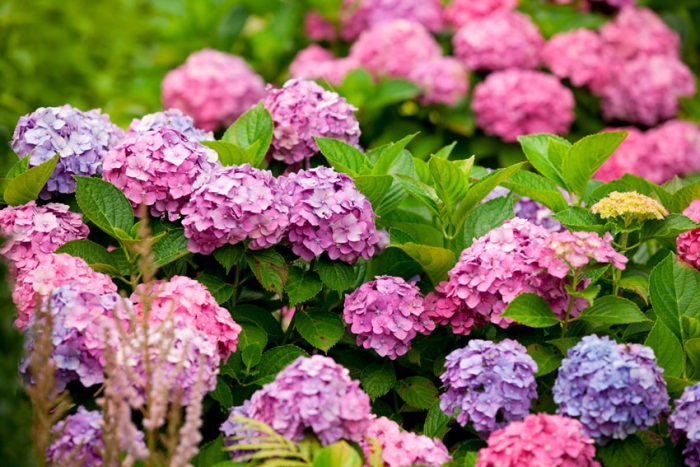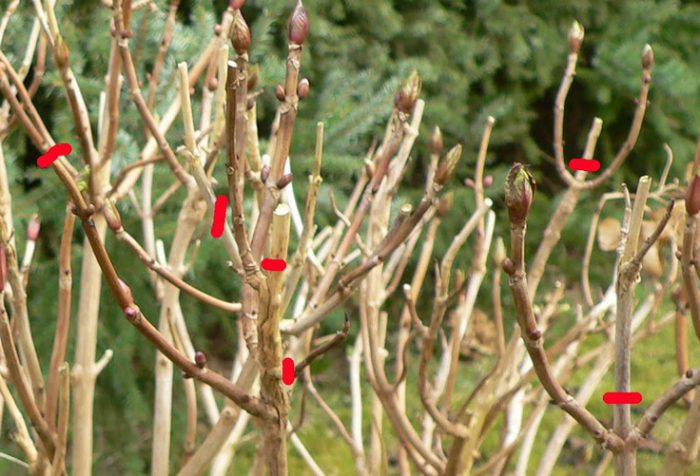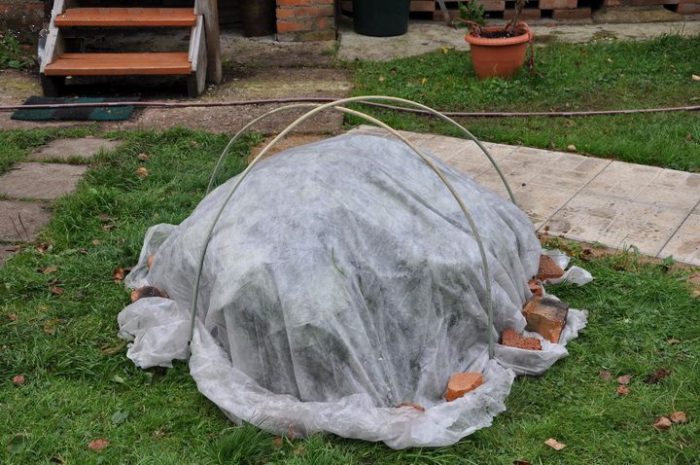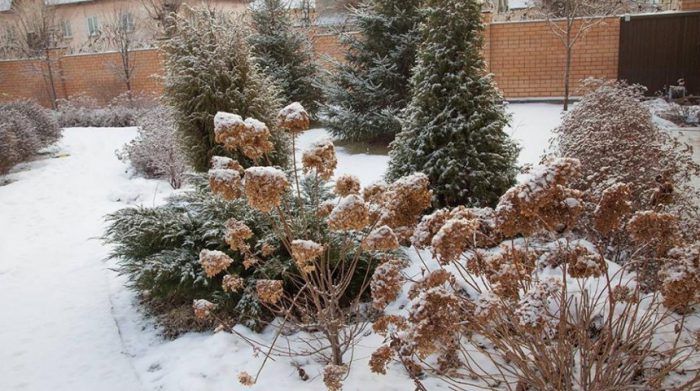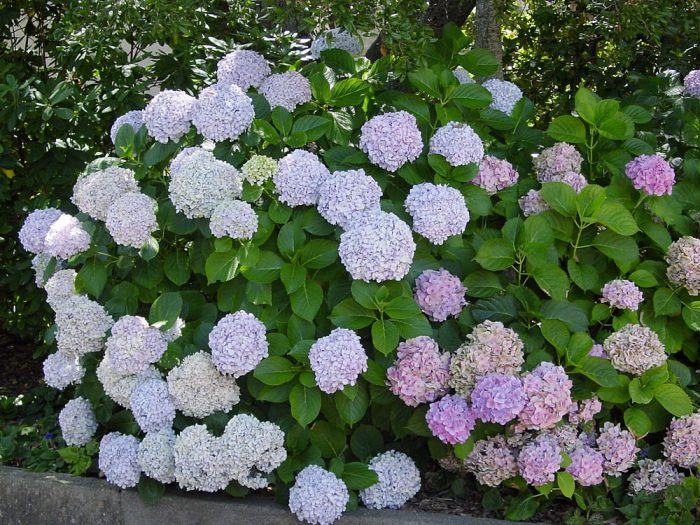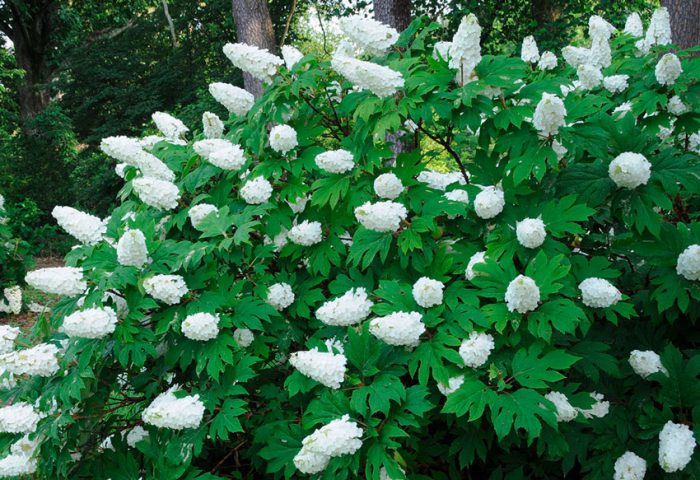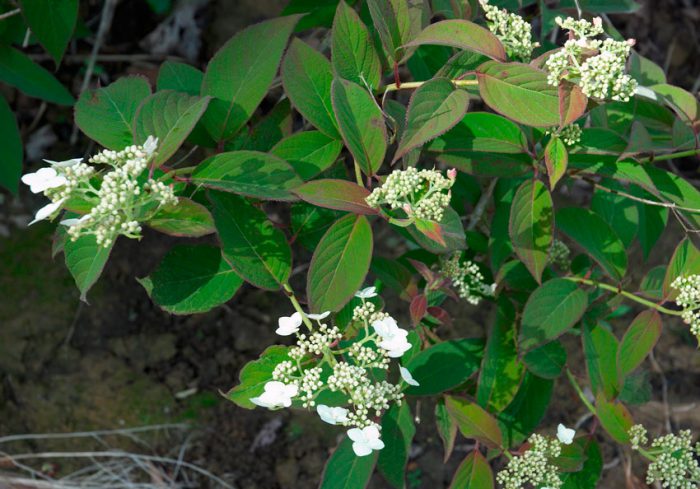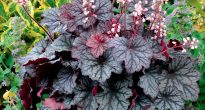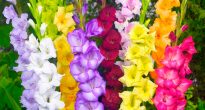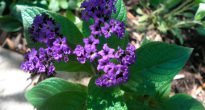A flowering plant such as hydrangea (Hydrangea) is directly related to the hydrangea family. According to various sources, this genus unites 30–80 species of hydrangeas. Such plants are represented by compact trees, vines and shrubs. Most of the hydrangea species grows in South, as well as East Asia (China, Japan), and this plant can also be found in North America and the Far East. Such a plant was named after the princess of the Holy Roman Empire. Systematics scientists gave the plant the Latin name Hydrangea, which means "a vessel with water". The fact is that it is highly moisture-loving. In Japan this plant is called "adzisai", which means "flower - purple sun". Despite the large number of species, only garden hydrangea, or large-leaved, having a small size, are grown at home. Other species and varieties are grown exclusively in gardens.
Content
Hydrangea features
In the wild, hydrangea is represented by three-meter shrubs, not very large trees, as well as lianas, which can climb the trunks of trees to a height of thirty meters. Also, such hydrangeas can be deciduous or evergreen (depending on the species). In the middle latitudes, deciduous species are most preferred. Most often, such a plant has opposite leaves of a large size, they are oval in shape with a pointed tip at the top. The edge of the leaf blades is most often serrated, and venation is clearly visible on their surface. Hydrangea begins to bloom in the spring, and ends only after the onset of frost in the fall. The flowers are collected in large inflorescences, which can have a corymbose, spherical or paniculate shape. The inflorescences include 2 types of flowers. Some of them are small fertile (fertile), usually located in the middle of the inflorescence, while others are large sterile (sterile), which are located along the edge of the inflorescences. There are species with only one fertile flowers. Most hydrangeas have white flowers.However, there are species, for example, large-leaved hydrangea or large-leaved hydrangea, which can have flowers of various colors: cream, white, blue, pink, red and lilac. At the same time, it is interesting that the pH of the soil affects the color of the flower. So, for example, if the substrate is neutral, then the flowers will be cream or beige, if alkaline, then pink or lilac, and sour - blue, because in the soil there is aluminum easily absorbed by hydrangea. The fruit of this flower is a box with 2–5 chambers, which contains small seeds. It happens that a flower belonging to a close genus schizophragmatic is mistakenly called a hydrangea, but you should know that petiolar hydrangea is nothing more than a schizophragma.
Growing hydrangea
How to properly grow hydrangea in the garden? Here are the basic rules:
- Large-leaved hydrangea can have a different color of flowers. Moreover, their color does not depend on the variety, but on the pH of the soil. So, in acidic soil, the flowers are blue and blue, in neutral - white and beige, and in alkaline - lilac or pink. In order for the bush to be spectacular and colorful, experienced gardeners are advised to change the acidity separately for each flower.
- This flower is very fond of moisture, in this regard, it must be watered not only abundantly, but also on time.
- Direct rays of the sun are required. But it should be borne in mind that flowers can fade under the influence of the scorching rays of the midday sun. In this regard, you need to choose a place for planting, where there would be little shade at noon.
- Also, the plant must be cut off in time.
- You cannot apply a lot of organic fertilizers, because flowers may not appear on the overgrown bushes.
- Hydrangea must be covered well for wintering, even those species that are considered frost-resistant. If any of the bushes freezes, then in most cases it will be able to fully recover during the period of intensive growth.
- Very resistant to diseases and pests.
Planting hydrangeas
Growing from seeds
Seeds are usually very easy to propagate for hydrangea species. Also, this breeding method is often used by breeders in their work. It is quite easy to grow such a flower from a seed, but it is a time-consuming method. You need to sow seeds in the autumn. To do this, you need to fill the container with a loose soil mixture rich in nutrients, which can be prepared by combining peat and leaf soil with river sand in a ratio of 2: 4: 1. Seeds sown on the surface of the substrate should be sprinkled with a thin layer of soil, and then watered with a spray bottle. Then the container must be covered from above with a transparent film or glass, while the shelter must be removed several times at knocks in order for the soil to be aired. It should also be taken into account that the soil should be slightly moist all the time. The optimum temperature is from 14 to 20 degrees. After the first seedlings appear, the shelter must be removed permanently. The pick must be done 2 times. The first time in the developmental stage of the cotyledons, and the second - in the first month of spring. At the same time, when diving a plant for the second time, you need to take small pots for each of them (diameter 7 centimeters). After you transplant young plants a second time, you need to start hardening them. To do this, flowers in the summer are taken out into the street and a place is chosen for them, which is protected from direct sunlight, gusts of wind, drafts and precipitation. In the evening, the hydrangeas are returned to the room. For 2 years, the hydrangea must be grown indoors, and in the winter it is kept in a fairly cool and lighted room, and in the summer it is transferred to the street. In this case, it is imperative to break off all the buds, since they will take a lot of energy from a still young plant.
Hydrangea seedlings
After 2 years, at the very beginning of the spring period (in areas with a cold climate - in the autumn), the grown flowers are transplanted into open soil, immediately to a permanent place. When choosing a suitable place, do not forget that all species are photophilous and need direct sunlight. However, there are several species (ground cover, Sargent, rough and tree) that thrive in partial shade. The soil should be loose, rich in organic matter, neutral or slightly acidic. Alkaline soil can be acidified by taking high-moor peat or Acid Plus acidifier. It is not recommended to plant trees or shrubs with a superficial root system next to these flowers, since after some time these plants will fight each other for water and nutrients.
The first step is to dig a hole, while its size should be 2 times the volume of the root system of the seedling together with the pulled out lump of earth. Then organic and mineral fertilizers, as well as peat, must be added to the hole, which should be mixed with the ground. Then the sapling taken out together with a lump of earth must be thoroughly shaken off the soil and the roots should be aligned. Then it is lowered into a hole, which is covered with a mixture of compost and soil. In this case, it is necessary for the root system to rise very slightly above the soil surface. Then the soil should be compacted, the bush should be watered and the area should be covered with mulch (bark or needles).
Outdoor Hydrangea Care
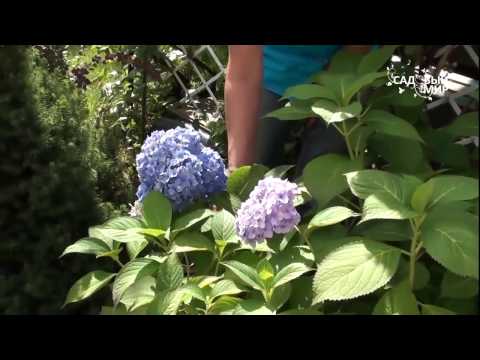

Watch this video on YouTube
Basic rules of care
It is not difficult to take care of such a plant grown in the open field, but it must be done correctly. Proper watering is of great importance for the normal development of hydrangea. So, in hot weather it needs to be watered 2 times in 7 days, while 3-5 ten-liter buckets of lukewarm and always settled water should be poured onto 1 adult bush. In the event that there is mulch in the form of peat on the site, then watering can be reduced.
In order for the roots to receive more oxygen, it is necessary to loosen the soil surface around the plant several times a season to a depth of about 5 centimeters. You also need to promptly cut off those stems that have already faded.
Fertilizing hydrangea
In order to achieve the most abundant flowering, you need to feed such a flower at least 2 times a year. This must be done before the plant begins to bloom and after it has faded. At the very beginning of the spring period, a urea solution (2 g per 1 liter of water) is used to feed hydrangeas. In this case, 1 bush will need 30 liters of this solution. When the plant has faded, a complex mineral fertilizer should be used to feed it. During the summer period, experts advise using slurry as top dressing. However, do not overdo it, because overfed hydrangeas have very large inflorescences that can break rather fragile branches. To avoid this, you can tie up a bush.
Pruning hydrangea
Should be cut off those bushes that are older than 3-4 years. Species blooming on the stems of the current year should be cut off at the very beginning of the spring period, before the buds begin to open, as well as before the start of sap flow, otherwise the plant may drain out of juice, which will lead to its death. However, after pruning done very early, cuttings should not be rooted. Therefore, pruning should be done at a time when the buds look alive and swell a little. The tree hydrangea is the very first to wake up, so it must be cut off first. Very long stems are cut off at a height of 3-4 buds. After that, the resulting twig can be divided into cuttings. Panicle hydrangea requires more careful pruning. So, last year's stems must be shortened by 1/3 part, but viable cuttings are obtained from such segments.Large-leaved hydrangea does not need to be heavily pruned. So, in spring, only every 4th stem is cut off, especially if it grows inside the bush. And also it is necessary to remove dried and damaged branches.
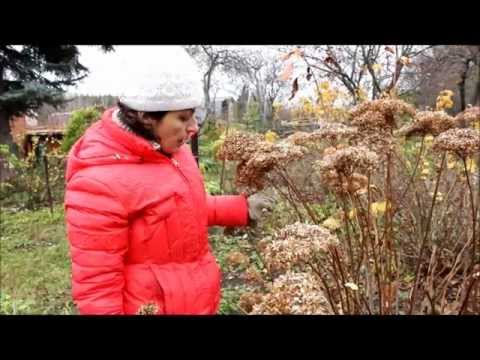

Watch this video on YouTube
Propagation of hydrangea by cuttings
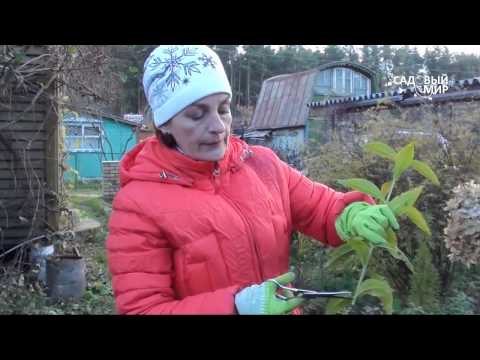

Watch this video on YouTube
After pruning the hydrangea, you will have a large number of stems that can be cut into cuttings. Each of the cuttings should have 2 nodes. In this case, the cut above the node located at the top should be straight, and under the one below it should be oblique. In this case, 2-3 centimeters should be retreated from the knot, and then a cut should be made. Fill the greenhouse container with a mixture of peat and sand and stick the cutting to a depth of 3 centimeters, while watering it well. After that, cover the greenhouse from above with a plastic wrap "house". The cuttings must be systematically moistened with a spray bottle so that the soil is always slightly moist. After complete rooting, the cuttings should be planted in open soil in a permanent place. They should have time to get stronger before winter.
Hydrangea after flowering
A faded plant must be prepared for wintering. Seedlings that are grown in containers must be moved indoors. For flowers growing in open ground, you need to cut off wilted flowers, because when wet from rain and snow, they will become very heavy and can break branches. And you will also need to spud the base of the bushes high enough, cover the soil surface around them with a layer of mulch, which will help protect the root system from freezing. The most frost-resistant species are ground cover and paniculate. The stems of such plants are completely lignified before the onset of the autumn period, which helps them to endure frost more easily, even if they are not covered (when grown in areas with mild winters). You can also not cover the tree hydrangea for the winter.
Hydrangea wintering
Preparing hydrangeas for winter
A rather warm and snowy winter period allows even species that love warmth (serrated and large-leaved hydrangea) to winter without shelter. However, it should be borne in mind that winter will be frosty or warm, no one knows exactly how and how much snow will fall. It is better to play it safe and, despite the fact that forecasters promise a warm winter, prepare the plants for wintering properly. Because if the forecast of weather forecasters is incorrect, then plants unprepared for wintering may die.
What time is it better to cover this flower and how to do it? As a rule, this procedure is carried out in October, after the first frosts have passed. If the bushes are young, then they should be covered to the top with dry soil. The grown bushes must be pressed to the soil surface and covered with roofing material or lutrasil. They must be fixed with bricks, since such a shelter can be blown away by the wind. More mature bushes will require more energy. The bush must be carefully tied and then covered with spunbond or lutrasil. After that, a metal mesh frame should be created around the bush, which should have a cylindrical shape. In this case, the walls of the structure should be removed from the bush by 20-25 centimeters, and they should also rise above it by 10 centimeters. Empty space in the structure should be filled with dry leaves. In springtime (in April) the net with leaves can be removed, but the spunbond is removed only after the threat of frost has passed.
Hydrangea in winter
You yourself can decide whether to cover these flowers for you or not. The options above are ideal for a frosty winter with poor snow cover. In the event that the place where you live is a very mild winter, then covering the hydrangea can be quite easy. And if you have winter-hardy species, then they can not be covered at all.However, if the winters where you live are often frosty, then it is better to take care of a shelter for the hydrangea in the autumn, and then you will definitely be sure that it can survive even severe frosts.
Types of hydrangea photos and names
If you are thinking about decorating your garden with hydrangea, then first of all you should pay attention to the features of the various types of this plant. Then you can choose exactly the types that will best suit your garden. It is also important to know how each species needs to be looked after. For example, a tree-like or large-leaved hydrangea must be prepared for wintering and cut in a slightly different way than panicle hydrangea. If you know a lot about the rules for caring for such plants, then caring for them will not be difficult.
Hydrangea tree (Hydrangea arborescens)
This variety is very popular among gardeners living in mid-latitudes. This plant is represented as a shrub. Its height can vary from 100 to 300 centimeters. Inflorescences grow on the tops of annual stems. When the flowers are just beginning to open, they have a light green color, after their full disclosure, they change their color to cream or white. The most popular varieties are: "Invizible Spirit" - flowers have a pink color; "Sterilis" - inflorescences are white, while this plant blooms very profusely; "Annabelle" and "Grandiflora" - have very large inflorescences, painted in a pure white color (note that panicle hydrangea has varieties with exactly the same names).
Hydrangea paniculata (Hydrangea paniculata)
Under natural conditions, such a plant has the shape of a tree or a shrub, the height of which can vary from 2 to 5 m. This species is considered one of the most popular among gardeners. Without transplanting in the same place, this type of hydrangea is able to grow and develop normally for more than 40 years. The stems of this plant are lignified in a relatively short time, which is why it is considered winter hardy. The inflorescences grow in the upper parts of the stems of this year, while the flowering is distinguished by its abundance. However, the buds formed in the last days of June open only in August or September. The inflorescences of this type of flowers have a pyramidal shape. When only the flowers begin to open, they have a pale green color, and after full disclosure, they turn white. At the end of the summer period, they turn light pink and then brick. When the flowering period begins to end, the flowers turn light green again. The most popular varieties are Grandiflora, Kuishu, Vanilla Freise and Tardiva.
Large-leaved hydrangea (Hydrangea macrophylla)
Or garden - it is often cultivated in the garden. However, individual varieties can be grown in containers indoors or on the terrace. Dense leaves have a rich green color. The stems of this year are herbaceous, which is why the bush has not very high cold resistance. It is believed that inflorescences appear on the stems of last year, since the buds for their growth are laid in the autumn, and they begin to grow in the spring. As a rule, inflorescences have a viburnum-shaped, umbellate shape, it is also called hemispherical or Japanese. The color of the flowers depends on the pH of the soil. Recently appeared interesting varieties: "Endless Summer" - in acidic soil - blue color, in neutral - lilac; Renata Steinger - blue; "Expression" and "Romance" have double flowers.
Hydrangea oakleaf (Hydrangea quercifolia)
It has low frost resistance and needs good insulation for the winter. It blooms very luxuriantly and has unusually attractive leaves. It has a height of about 2 m. The length of paniculate inflorescences is from 10 to 30 centimeters. Flowering begins in June-July, while at the beginning the flowers are white, and then turn purple.
Ground cover hydrangea (Hydrangea heteromalla)
Or hydrangea with different pubescence - a winter-hardy species. Under natural conditions, it can reach a height of 200-300 centimeters. Often used to form a standard form. The length of the dark green leaves is about 20 centimeters. Their front side is smooth, and the seamy side has pubescence. Loose corymbose inflorescences are initially white, and then turn pink at the end of flowering. Flowering begins in the last June days or the first July. The most popular ground cover variety Bretschneider, which blooms profusely with rather large inflorescences of a milky white color.
Also, gardeners grow hydrangeas: ash, serrate, radiant, rough, Sargent. They also grow a climbing type of petiolate hydrangea, but as mentioned above, this is not a hydrangea.
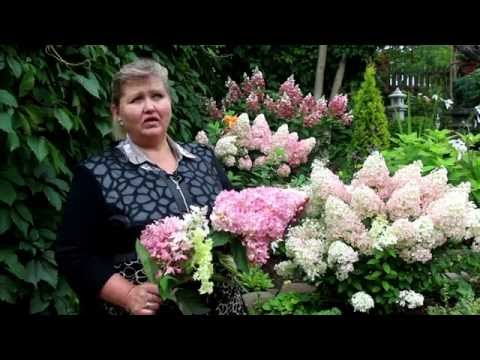

Watch this video on YouTube

